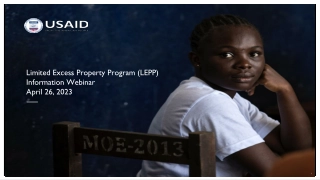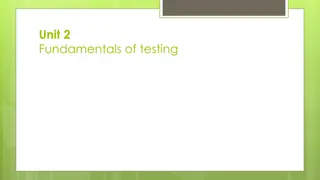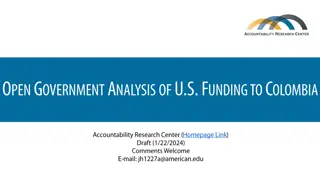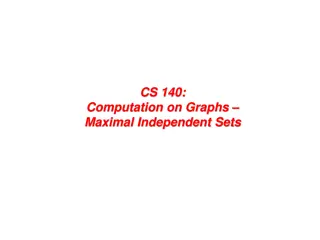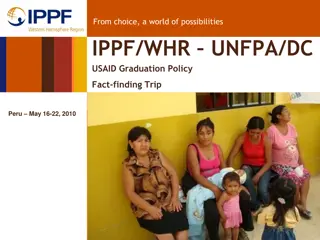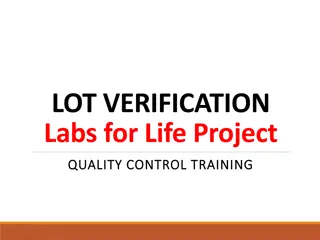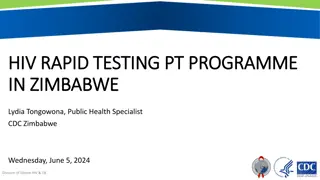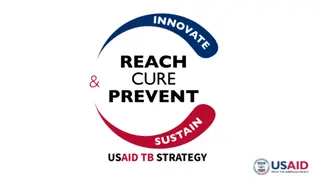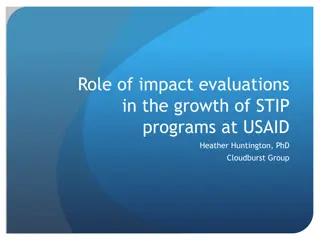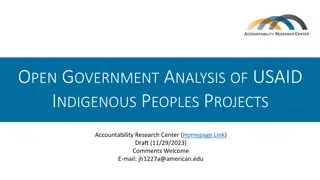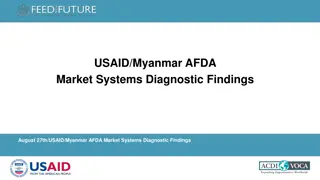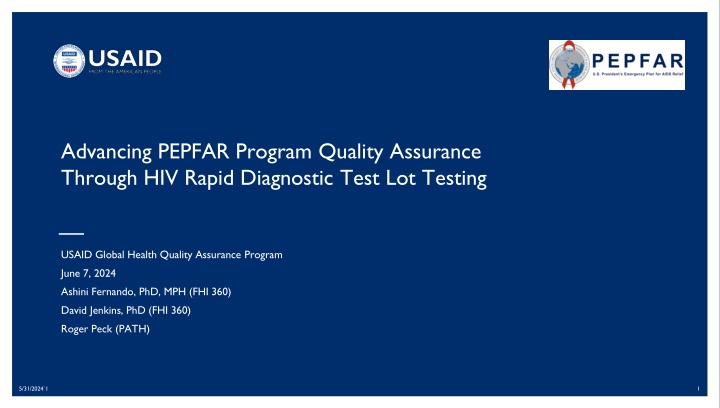
Advancing PEPFAR Program Quality Assurance Through HIV Rapid Diagnostic Test Lot Testing
Explore how the USAID Global Health Quality Assurance Program is enhancing quality assurance in PEPFAR through HIV rapid diagnostic test lot testing, with a focus on standardization, testing outcomes, and partnership objectives between FHI 360 and USAID. Learn about the methodologies, sampling strategies, and incident management protocols implemented for the PEPFAR HIV RDT Lot Testing Program.
Download Presentation

Please find below an Image/Link to download the presentation.
The content on the website is provided AS IS for your information and personal use only. It may not be sold, licensed, or shared on other websites without obtaining consent from the author. If you encounter any issues during the download, it is possible that the publisher has removed the file from their server.
You are allowed to download the files provided on this website for personal or commercial use, subject to the condition that they are used lawfully. All files are the property of their respective owners.
The content on the website is provided AS IS for your information and personal use only. It may not be sold, licensed, or shared on other websites without obtaining consent from the author.
E N D
Presentation Transcript
Advancing PEPFAR Program Quality Assurance Through HIV Rapid Diagnostic Test Lot Testing USAID Global Health Quality Assurance Program June 7, 2024 Ashini Fernando, PhD, MPH (FHI 360) David Jenkins, PhD (FHI 360) Roger Peck (PATH) 5/31/2024`1 1
Objectives Introduction to FHI 360 and USAID partnership PEPFAR HIV RDT lot testing program HIV RDT lot testing standardization HIV RDT testing outcomes 5/31/2024 USAID Global Health Supply Chain Program 2
FHI 360 and USAID Partnership FHI 360 s Product Quality and Compliance (PQC) department provides independent and objective quality assurance and quality control services to clients. PQC has staff in the United States, Thailand, and South Africa; ISO 17025-accredited testing laboratories in United States and Thailand; ISO 9001-certified quality management system. Through the USAID Global Health Supply Chain-Quality Assurance Program (GHSC-QA), FHI 360 delivers comprehensive quality assurance services employing a risk-based approach to ensure the safety, efficacy, and quality of health commodities procured on behalf of USAID. GHSC-QA contract objectives Quality assurance Quality control Technical assistance Global collaborations https://www.fhi360.org/projects/global-health-supply-chain-quality-assurance-program-ghsc-qa/ 5/31/2024 USAID Global Health Supply Chain Program 3
Test method development Sampling strategy Product manufacturing consistency monitoring Incident management PEPFAR HIV RDT Lot Testing Program 1 Notification of HIV RDT orders (and incidents) GHSC-QA Communicate results and next steps to procurement groups 5 Procurement groups WHO-prequalified HIV RDTS Coordinate with sampling agents 4 2 Result reporting within 6 weeks 200 HIV RDT samples mailed 3 Sampling agents 3 testing laboratories 5/31/2024 USAID Global Health Supply Chain Program 4
HIV RDT Testing Standardization Guided by ISO 2859-1:1999 Sampling Procedures for Inspection by Attributes Key questions addressed: How many HIV RDTs to test? Sample Size What are the attributes applied to accept or reject a lot? Nonconformant results What should be the percent level of nonconformant results in a lot that is tolerated by a user? Acceptance Quality Limits (AQL) o Factors considered: stringency, WHO guidance on HIV RDT sensitivity and specificity, waste How should we qualify specimen panels? o Factors considered: specimen types, availability, cost, and storage How should the RDTs be monitored? Sampling plan 5/31/2024 USAID Global Health Supply Chain Program 5
Sample Size and Acceptance Quality Limit (AQL) Determination Based on ISO 2859-1 Stringency Stringency 5/31/2024 USAID Global Health Supply Chain Program 6
Optimal AQL and Inspection Level for HIV RDTs: 0.65, S-4 Sampling plan 80 HIV-positive unique specimens with 80 HIV RDTs 80 HIV-negative unique specimens with 80 HIV RDTs AQL: accept 1 nonconformant reject 2 nonconformants Alternative sampling plan 20 positive specimens in quadruplicate with 80 RDTs 20 negative specimens in quadruplicate with 80 RDTs AQL: accept 1 nonconformant reject 2 nonconformants PloS One, 18(4), e0284175. https://doi.org/10.1371/journal.pone.0284175 5/31/2024 USAID Global Health Supply Chain Program 7
A Snapshot of HIV Specimen Panel Qualification Outcomes with 5 HIV RDT brands Each specimen in 4 replicate/panel 3 lots per brand of HIV RDTs tested 5/31/2024 FOOTER GOES HERE 8
HIV RDT Sampling Plan Qualification Score Minimum lots tested to reach next levels Test frequency Sample number to test Testing level 1 - 15 100% 80 positive and 80 negative Testing level 2 75 50 100% 80 positive and 80 negative Testing level 3 250 75 Skip lot 1 in 4 80 positive and 80 negative Testing level 4 375 - 1 per quarter 20 positive and 20 negative *Qualification score determination For 80 positives and 80 negatives; AQL 0.65, 1 accept/2 reject If a lot is accepted with 0 nonconformities, add 5 to the qualification score If a lot is accepted with 1 nonconformity, add 1 to the qualification score Any lot not accepted results in the QA being reset to 0 ISO 2859-3: Skip lot sampling procedure USAID Global Health Supply Chain Program 5/31/2024 9
PEPFAR HIV RDT Lot Testing Outcomes Approximate number of HIV or HIV/syphilis combo brands tested: 24 Lots tested Lots not tested 124 1 127 5 I incident 7 lots rejected Total lots procured USAID Global Health Supply Chain Program 2,516 5/31/2024 10
Investigation Results in Improvements to the Instructions for Use for a HIV Rapid Diagnostic Test Product was quarantined after yielding false positive results. Testing through GHSC-QA and by the manufacturer found a higher rate of invalid results occurred when the RDT was used directly on a laboratory bench or a plastic surface, but invalid results did not occur when tests were used on a paper- backed surface. This phenomenon is attributed to static electricity that affects the volume of buffer dispensed in a droplet from the buffer bottle. As a result of the investigation: The manufacturer prepared updates to the instructions for use to read that testing be performed on a paper-based surface. Manufacturer submitted a notification of labeling change to WHO Prequalification. This labeling change will safeguard future procurements that use this HIV RDT as a component of their testing algorithm. FHI 360 and PATH worked closely and communicated regularly with global stakeholders including WHO, USAID, the Global Fund, the USAID Global Health Supply Chain-Technical Assistance (GHSC-TA) program, and the USAID Global Health Supply Chain-Rapid Test Kit (GHSC-RTK) program. FHI 360 also maintained a positive collaboration with the manufacturer as each entity worked to investigate the concern of invalid results 5/31/2024 USAID Global Health Supply Chain Program 11
Acknowledgments This work was supported through the United States Agency for International Development Contract No. AID-OAA- C-15-00001 FHI 360 o David Jenkins, PhD o Mary Beth Sowers o Michael Payne o Arno Hensens o Jeffery Tremelling PATH o Roger Peck o Becky Barney University of Maryland, Baltimore o Niel Constantine, PhD o 5/31/2024 USAID Global Health Supply Chain Program 12

